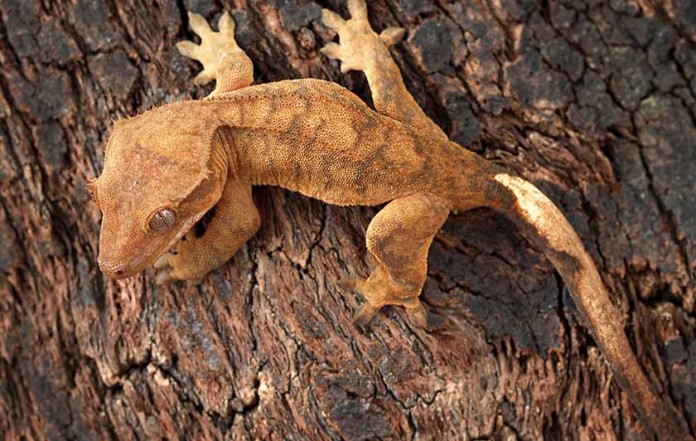Crested gecko housing should make the animal feel secure and comfortable, yet provide plenty of space to move around. Crested geckos are arboreal animals and require housing that is tall to facilitate their natural instinct to climb. There are several types of enclosures that you can provide for the captive crested gecko, and there are certain considerations to keep in mind when housing them.
Housing Sexes
If you would like to have more than one crested gecko keep in mind that you cannot house two males, as they will fight for territory. It is safe to keep up to one male and two females together in a 29-gallon aquarium. Male and female hatchlings can be kept together until they reach sexual maturity.
Hatchlings
Hatchlings up to four months should be kept in a smaller enclosure, as they have been known to not eat well if the enclosure is too large. Hatchlings up to four months feel more secure in smaller enclosures, preferably a 10-gallon aquarium. Kritter Keepers are ideal, as they are small enough so that the baby and juvenile geckos can find food easily. The crested gecko can be moved to a larger enclosure once it is four months old.
Reptile Terrarium
There are specially made reptile terrariums available in pet stores and online that are designed specifically for the height requirements of reptiles. When selecting housing for your crested gecko, it is important to note that height is most important as the crested loves to climb.
Ventilation
 You can choose glass, plastic or screened enclosures for housing your crested gecko. Ventilation is another key factor to keep in mind when selecting your pet’s new home. Without proper ventilation, the habitat will become stagnant and become a breeding ground for fungus. If you choose a glass aquarium, make sure that the lid is screen, as this will allow ample ventilation.
You can choose glass, plastic or screened enclosures for housing your crested gecko. Ventilation is another key factor to keep in mind when selecting your pet’s new home. Without proper ventilation, the habitat will become stagnant and become a breeding ground for fungus. If you choose a glass aquarium, make sure that the lid is screen, as this will allow ample ventilation.
Screen cages are great, as they allow thorough ventilation and climbing opportunity for the crested gecko. The one drawback is that they do not hold in humidity and this can lead to shedding problems and lack of hydration for the gecko. You can remedy this by misting the enclosure twice daily or by enclosing part of the cage with plastic.
The most important factors involved with proper crested gecko housing are security, height, ventilation and humidity. When selecting your crested gecko’s new habitat, remember these important aspects to ensure that your pet is healthy and happy.
Natural Habitat of Crested Gecko
Good understanding of crestie natural is important in setting up a good environment for the geckos.
Crested Gecko Tank and Its Habitat
Crested gecko natural habitat can be duplicated as simple or as extravagant as you choose, as long as it is set up and maintained properly.
Crested Gecko Tank Setup
Tank setup is relatively easy and includes substrate, objects and plants for climbing and hiding, and proper temperature and humidity.
Glass Cage or Screen Cage
The cage comes in a variety of sizes and designs in glass or screen and should accommodate the gecko’s natural instinct to climb. How to choose one?
Vivarium: The Place of Life
It should be secure, comfortable and contain those items that allow your pet to thrive.
Crested Gecko Water Requirement
It is important for the reptile’s overall health and proper shedding, and can be provided through daily misting.











